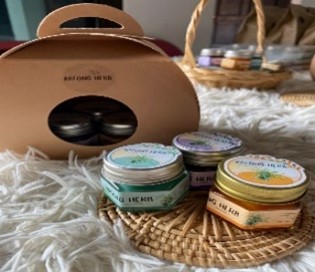วุฒิชัย คงยัง การพัฒนาสินค้าอัตลักษณ์เชิงพื้นที่ด้วยนวัตกรรมการสกัดเย็น ในเขตอำเภอยะหา จังหวัดยะลา : กรณีศึกษาบาล์มสมุนไพร
Main Article Content
บทคัดย่อ
DOI : 10.14456/pnuhuso.2024.6
การวิจัยครั้งนี้มีวัตถุประสงค์เพื่อ 1) พัฒนาผลิตภัณฑ์จากสมุนไพรที่มีอยู่ในอำเภอยะหา จังหวัดยะลา มาสร้างเป็นสินค้า 2) พัฒนาบรรจุภัณฑ์และตราสินค้าจากสมุนไพรที่มีอยู่ในชุมชนและท้องถิ่น 3) นำนวัตกรรมมายกระดับสมุนไพรทางการเกษตรมาผลิตเป็นสินค้าของพื้นที่ การวิจัยครั้งนี้เป็นการวิจัยเชิงคุณภาพ โดยการวิเคราะห์เนื้อหา ด้วยวิธีการสุ่มกลุ่มตัวอย่างเเบบเจาะจง และเก็บข้อมูลจากการสัมภาษณ์แบบเชิงลึก การสัมภาษณ์กลุ่ม และการสังเกตการมืส่วนร่วม ทำการวิเคราะห์ข้อมูลจากเนื้อหาแล้วบรรยายเชิงพรรณนา จากกลุ่มตัวอย่างที่ประกอบอาชีพตัดเย็บเสื้อผ้าจำนวน 17 คน และกลุ่มตัวอย่างที่ประกอบอาชีพทำสมุนไพรไม้หอมจำนวน 13 คน ในพื้นที่อำเภอยะหา จังหวัดยะลา
ผลการวิจัยพบว่า กลุ่มตัวอย่างมีการพัฒนาผลิตภัณฑ์จากสมุนไพรที่มีอยู่ในพื้นที่มาสร้างเป็นสินค้า ให้เกิดมูลค่าเพิ่ม เกิดการพัฒนาบรรจุภัณฑ์และตราสินค้าจากสมุนไพรที่มีอยู่ในชุมชนและท้องถิ่น รวมทั้ง การนำนวัตกรรมการสกัดเย็นมาพัฒนาสินค้า ที่เกิดจากการผลิตจากวัตถุดิบที่มีอยู่ภายในท้องถิ่นที่มีลักษณะเฉพาะของพื้นที่ มาทำการผลิตสินค้าที่อาศัยข้อได้เปรียบด้านสมุนไพรเชิงอัตลักษณ์ในพื้นที่ นอกจากนี้ยังพบว่าการให้ความสำคัญกับปัญหาด้านการตลาดที่ยังขาดการสื่อสารทางการตลาดเพื่อสร้างการรับรู้และยังมีช่องทางในการจัดจําหน่ายแบบดั้งเดิม การประสบปัญหาด้านการบริหารจัดการที่ยังไม่มีการวางแผน ด้านกิจกรรมโลจิสติกส์ แผนการผลิต คุณภาพของผลิตภัณฑ์ ระบบการจัดการ กิจกรรมด้านการจัดหา การวางแผนการจัดซื้อ และการวางแผนการจัดการวัตถุดิบ
Article Details

อนุญาตภายใต้เงื่อนไข Creative Commons Attribution-NonCommercial-NoDerivatives 4.0 International License.
เอกสารอ้างอิง
กนกวรรณ ภู่ไหม. (2559). การศึกษาปัจจัยสนับสนุนการสร้างนวัตกรรมองค์กร บริบทธนาคารพาณิชย์ [วิทยานิพนธ์ปริญญามหาบัณฑิต, มหาวิทยาลัยธรรมศาสตร์]. https://ethesisarchive.library.tu. ac.th/thesis/2016/TU_2016_5823030035_5590_6325.pdf
กฤตภัค ไม้เรียง. (2563). รูปแบบนวัตกรรมบริหารธุรกิจวิสาหกิจขนาดกลางและขนาดย่อม. วารสารสังคมศาสตร์และมานุษยวิทยาเชิงพุทธ, 5(2), 255-268.
จิตพนธ์ ชุมเกตุ. (2560). การพัฒนาผลิตภัณฑ์จากภูมิปัญญาท้องถิ่นเพื่อเพิ่มประสิทธิภาพทางการจัดการชุมชนอย่างยั่งยืนของชุมชนไทยมุสลิมอําเภอชะอําจังหวัดเพชรบุรี (รายงานการวิจัย). มหาวิทยาลัยศิลปากร. http://www.mis.ms.su.ac.th/MISMS01/PDF03/132_20190626_.pdf
ฉัตรธิดา หยูคง และศักรินทร์ ชนประชา. (2566). การพัฒนาผลิตภัณฑ์สมุนไพรบนฐานองค์ความรู้ภูมิปัญญาและพืชอัตลักษณ์ท้องถิ่นของวิสาหกิจชุมชนสมุนไพรคุณธรรมวัดคูเต่า ตำบลแม่ทอม อำเภอบางกล่ำ จังหวัดสงขลา. วารสารวิจยวิชาการ, 6(3), 201-214.
ตฤณวรรธน์ ธนิตนิธิพันธ์. (2565). แนวทางการพัฒนาศักยภาพยาและผลิตภัณฑ์จากสมุนไพรไทยสู่มาตรฐานสากล. วารสารรัฎฐาภิรักษ์วิทยาลัยป้องกันราชอาณาจักร, 64(3), 54-66.
เพ็ญนภา ทิพย์สุราษฎร์. (2559). การศึกษาพืชสมุนไพรท้องถิ่นและภูมิปัญญาด้านการใช้พืชสมุนไพรกรณีศึกษา: อุทยานแห่งชาติแก่งกรุงจังหวัดสุราษฎร์ธานี [วิทยานิพนธ์ปริญญามหาบัณฑิต, มหาวิทยาลัยสงขลานครินทร์]. https://kb.psu.ac.th/psukb/bitstream/2016/11486/1/4179 07.pdf
พันธุ์อาจ ชัยรัตน์. (2564). "มองนวัตกรรมกับอนาคตประเทศไทยผ่าน (ร่าง) แผน 13". https://www. bangk o k biznews.com/blogs/columnist/127813
มรกต กำแพงเพชร. (2557). ผู้ประกอบการ SMEs กับการพัฒนาภูมิปัญญาท้องถิ่นสู่สินค้านวัตกรรม. วารสารธุรกิจปริทัศน์, 6(1), 219-227.
สำนักงานนวัตกรรมแห่งชาติ (สนช.). (2562). "4 ยุทธศาสตร์ผลักดัน ‘ไทย’ ให้เป็นประเทศแห่งนวัตกรรม". https:// www.nia.or.th/NIA4
สุภัทร คำมุงคุณ (2562). การเกษตรสร้างมูลค่าตามยุทธศาสตร์ชาติ 20 ปี. สถานีวิทยุกระจายเสียงรัฐสภาและสำนักวิชาการ.
Brunori, S R., & Knickel J. P. K. (2009). Towards a Better Conceptual Framework for Innovation Processes in Agriculture and Rural Development From Linear Models to Systemic Approaches. The Journal of Agricultural Education and Extension, 15(2), 131-146.
Pasini, F R., & Andrade S. D. (2020). Syntropy and innovation in agriculture. Current Opinion in Environmental Sustainability, 45(1), 20-24.
Yiwen, B.(2020). Innovative Cold Plasma-Assisted Extraction for Fioactive Compounds from Agricultural by Products [Master’s thesis]. University In Indiana.


